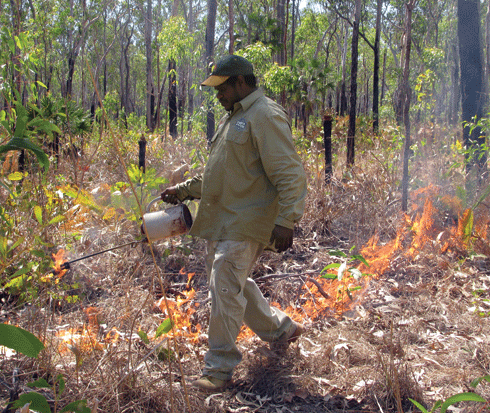
|
Published:
Managing Tiwi fires for greenhouse gas abatement
The economic potential of carbon is the focus of a new collaborative fire project on the Tiwi Islands, 80 km north of Darwin in the Northern Territory.
Nearly half of the Tiwi Islands are burnt every year, resulting in significant greenhouse gas emissions being released from vegetation and soil. Reducing the extent of fire may provide substantial financial benefits under the emerging carbon economy.
Tiwi leaders have identified the urgency of developing an independent economy as a sustainable means of improving the well-being of Tiwi people. In a research partnership developed over the past two years, the Tiwi Land Council Rangers, the Tiwi College and CSIRO are working together to explore livelihood opportunities for managing fire to reduce greenhouse gas emissions, while maintaining the special biodiversity values of the Tiwi Islands. The project is based on Melville Island, which at 570 000 hectares is Australia’s second largest island.
Burning influences greenhouse gas dynamics in two ways.
First, the potent gases methane and nitrous oxide are released into the atmosphere during savanna burning. Such emissions can be reliably quantified, and they directly contribute to Australia’s greenhouse gas accounts. They form the basis of current emission abatement activities being conducted on Aboriginal lands under the coordination of the North Australia Indigenous Land and Sea Management Alliance.
Second, fire affects the capacity of vegetation and soil to store carbon. Such carbon sequestration is not recognised under current greenhouse gas accounting rules, but with increasing pressure for full carbon accounting there is a high priority to quantify its potential.
CSIRO ecologist Dr Alan Andersen said studying the effects of different fire management options on carbon sequestration, greenhouse gas emissions and biodiversity is critical to quantifying the benefits from better fire management on the Tiwi Islands.
‘Our modelling indicates that there could be substantial increases in carbon stocks and reductions in emissions of greenhouse gases from reducing fire frequency. This could also have important biodiversity benefits,’ Dr Andersen said.
Tiwi Ranger, Willie Rioli, said there may be future jobs and money for fire management if reductions in greenhouse gases can be properly measured.
‘That’s why we have partnered with CSIRO on the Tiwi Carbon Study and that’s why the Tiwi College students are involved,’ Mr Rioli said.
‘We need good science to help us measure the effects of different types of fires on carbon storage in the bush, and we need our kids to learn the science so they can look after country properly in the future.’
The Tiwi College is owned and operated by the Tiwi people through the Tiwi Education Board. Students are immersed in ‘24-hour education’ combining classroom learning with sport, life skills, outdoor education and contributions to the life of the College. The College is developing a state-of-the-art science and environmental monitoring centre where students and teachers will work with CSIRO scientists to apply their learning to practical scientific projects.
Tiwi College Principal, Peter McNamara, said the Tiwi Carbon Study is helping students to see the relevance of science to fire management.
‘It’s an exciting opportunity for the students to be part of science in action,’
he said.
Mr Rioli said the Tiwi people wanted to develop economic opportunities, and the emerging carbon market could present some exciting possibilities for future management of their lands.
‘However, we want to make sure that our burning also looks after Tiwi plants and animals.’
The Tiwi Carbon Study features a series of long-term monitoring plots subject to different fire management options. The plots are the focus of ongoing monitoring and research on the effects of fire on tree dynamics, carbon sequestration and biodiversity.
More information:
The Tiwi Carbon Study, http://www.csiro.au/science/Fire-Carbon-Study.html




